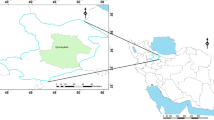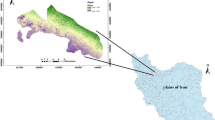Abstract
One of the key elements in improved management and better planning for aquifer maintenance is the ability to predict changes in aquifer depth. In order to forecast changes in aquifer depth in Qazvin plain, four methods, including Classification and Regression Tree (CART), Reduced Error Pruning Trees (RepTree), M5-Pruned (M5P), and M5Rule, were used in this work. The absolute mean error (MAE) and coefficient of determination (R2) data show that the CART algorithm performs better than other algorithms at forecasting changes in aquifer depth. The CART algorithm's prediction findings showed that the aquifer's behavior in the two seasons was entirely different. In the first stage, which began in November and continued through April, there was an annual average depth of 0.045 m. The aquifer depth has been greatly influenced by rising precipitation and falling air temperature. The aquifer experiences an average decline of 0.15 m in the second portion, which runs from May to October. Aquifer depth has significantly decreased as a result of declining natural water supplies and rising agricultural water use. It is advised to utilize a crop scheme with reduced water need when rainfall reduces due to the strong effect of changes in aquifer depth from rainfall with a delay of one to three months ago.


Similar content being viewed by others
Availability of Data and Materials
Not applicable.
References
Bai Y, Chen Z, Xie J, Li C (2016) Daily reservoir inflow forecasting using multiscale deep feature learning with hybrid models. J Hydrol 532:193–206
Breiman L, Friedman JH, Stone CJ, Olshen RA, Stone CJ (1996) Classification and regression trees (wadsworth, belmont, ca, 1984). In Proceedings of the Thirteenth International Conference, Bari, Italy (p. 148)
De Vos NJ, Rientjes THM (2007) Multi-objective performance comparison of an artificial neural network and a conceptual rainfall—runoff model. Hydrol Sci J 52(3):397–413
Demirel MC, Venancio A, Kahya E (2009) Flow forecast by SWAT model and ANN in Pracana basin, Portugal. Adv Eng Softw 40(7):467–473
Devasena CL (2014) Comparative analysis of random forest, REP tree and J48 classifiers for credit risk prediction. Int J Comput Appl 0975–8887
Dong Y, Jiang C, Suri MR, Pee D, Meng L, Rosenberg Goldstein RE (2019) “Groundwater level changes with a focus on agricultural areas in the Mid-Atlantic region of the United States, 2002–2016. Environ Res 171:193–203. https://doi.org/10.1016/j.envres.2019.01.004
Ebrahimi H, Rajaee T (2017) Simulation of groundwater level variations using wavelet combined with neural network, linear regression and support vector machine. Glob Planet Change 148:181–191. https://doi.org/10.1016/j.gloplacha.2016.11.014
Fayyad U, Piatetsky-Shapiro G, Smyth P (1996) From data mining to knowledge discovery in databases. AI Mag 17(3):37–37
Humphrey GB, Gibbs MS, Dandy GC Maier HR (2016) A hybrid approach to monthly streamflow forecasting: integrating hydrological model outputs into a Bayesian artificial neural network. J Hydrol 540:623–640
Iran’s Ministry of Agriculture (2017) Annual reports. Office of Economic Affairs
Jeihouni E, Eslamian S, Mohammadi M, Zareian MJ (2019) Simulation of groundwater level fluctuations in response to main climate parameters using a wavelet–ANN hybrid technique for the Shabestar Plain, Iran. Environ Earth Sci 78(10):1–9
Khatri N, Tyagi S (2015) Influences of natural and anthropogenic factors on surface and groundwater quality in rural and urban areas. Front Life Sci 8(1):23–39
Kuil L, Carr G, Prskawetz A, Salinas JL, Viglione A, Blöschl G (2019) Learning from the ancient maya: Exploring the impact of drought on population dynamics. Ecol Econ 157:1–16
Liu CY, Chia Y, Chuang PY, Chiu YC, Tseng TL (2018) Impacts of hydrogeological characteristics on groundwater-level changes induced by earthquakes. Hydrogeol J 26(2):451–465
Makwana JJ, Tiwari MK (2017) Hydrological stream flow modelling using soil and water assessment tool (SWAT) and neural networks (NNs) for the Limkheda watershed, Gujarat. India Model Earth Syst Environ 3(2):635–645
Mehran A, AghaKouchak A, Nakhjiri N, Stewardson MJ, Peel MC, Phillips TJ, Wada Y, Ravalico JK (2017) Compounding impacts of human-induced water stress and climate change on water availability. Sci Rep. https://doi.org/10.1038/s41598-017-06765-0
Milewski A, Lezzaik K, Rotz R (2020) Sensitivity analysis of the groundwater risk index in the Middle East and North Africa region. Environ Processes. https://doi.org/10.1007/s40710-019-00421-7
Minnig M, Moeck C, Radny D, Schirmer M (2018) Impact of urbanization on groundwater recharge rates in Dübendorf, Switzerland. J Hydrol 563:1135–1146
Moazamnia M, Hassanzadeh Y, Nadiri AA, Khatibi R, Sadeghfam S (2019) Formulating a strategy to combine artificial intelligence models using Bayesian model averaging to study a distressed aquifer with sparse data availability. J Hydrol 571:765–781
Mohamed WNHW, Salleh MNM, Omar AH (2012) A comparative study of reduced error pruning method in decision tree algorithms. 2012 IEEE International Conference on Control System, Computing and Engineering (ICCSCE). IEEE, pp. 392–397
Nadiri AA, Naderi K, Khatibi R, Gharekhani M (2019) Modelling groundwater level variations by learning from multiple models using fuzzy logic. Hydrol Sci J 64(2):210–226
Nayak PC, Venkatesh B, Krishna B, Jain SK (2013) Rainfall-runoff modeling using conceptual, data driven, and wavelet based computing approach. J Hydrol 493:57–67
Quinlan JR (1986) Simplifying decision trees. Proc workshop on Knowledge Acquisition for Knowledge-based Systems, Banff, Canada
Roshni T, Jha MK, Drisya J (2020) Neural network modeling for groundwater-level forecasting in coastal aquifers. Neural Comput Appl 1–18
Sadeghfam S, Hassanzadeh Y, Khatibi R, Nadiri AA, Moazamnia M (2019) Groundwater remediation through pump-treat-inject technology using optimum control by artificial intelligence (OCAI). Water Resour Manag 33(3):1123–1145
Sahay RR, Srivastava A (2014) Predicting monsoon floods in rivers embedding wavelet transform, genetic algorithm and neural network. Water Resour Manag 28(2):301–317
Salerno F, Tartari G (2009) A coupled approach of surface hydrological modelling and wavelet analysis for understanding the baseflow components of river discharge in karst environments. J Hydrol 376(1–2):295–306
Sapriza- Azuri G, Jódar J, Navarro V, Slooten LJ, Carrera J, Gupta HV (2015) Impacts of rainfall spatial variability on hydrogeological response. Water Resour Res 51(2):1300–1314
Sarma R, Singh SK (2022) A comparative study of data-driven models for groundwater level forecasting. Water Resour Manag 1–16
Yousefi H, Zahedi S, Niksokhan MH, Momeni M (2019) Ten-year prediction of groundwater level in Karaj plain (Iran) using MODFLOW2005-NWT in MATLAB. Environ Earth Sci 78(12):343
Zeng Y, Xie Z, Zou J (2017) Hydrologic and climatic responses to global anthropogenic groundwater extraction. J Clim 30(1):71–90
Zheng H, Chen L, Han X, Zhao X, Ma Y (2009) Classification and regression tree (CART) for analysis of soybean yield variability among fields in Northeast China: The importance of phosphorus application rates under drought conditions. Agr Ecosyst Environ 132(1–2):98–105
Acknowledgements
The authors of this article acknowledge the grants and financial support provided by the University of Zabol, from research site IR-UOZ-GR-0303.
Funding
The University of Zabol, from research site IR-UOZ-GR-0303.
Author information
Authors and Affiliations
Contributions
Seyed Hassan Mirhashemi: conceptualization, methodology, formal analysis, investigation, data curation, writing original draft preparation, visualization. Farhad Mirzaei: conceptualization, writing original draft preparation, writing review and editing, supervision, project administration. Parviz Haghighat Jou: conceptualization, writing original draft preparation, writing review and editing, supervision, project administration. Mehdi Panahi: conceptualization, writing review and editing, supervision.
Corresponding author
Ethics declarations
Ethical Approval
There are no relevant waivers or approvals.
Consent to Participate
Authors consent to their participation in the entire review process.
Consent to Publish
Authors allow publication if the research is accepted.
Competing Interests
Not applicable.
Additional information
Publisher's Note
Springer Nature remains neutral with regard to jurisdictional claims in published maps and institutional affiliations.
Rights and permissions
Springer Nature or its licensor holds exclusive rights to this article under a publishing agreement with the author(s) or other rightsholder(s); author self-archiving of the accepted manuscript version of this article is solely governed by the terms of such publishing agreement and applicable law.
About this article
Cite this article
Mirhashemi, S., Mirzaei, F., Haghighat Jou, P. et al. Evaluation of Four Tree Algorithms in Predicting and Investigating the Changes in Aquifer Depth. Water Resour Manage 36, 4607–4618 (2022). https://doi.org/10.1007/s11269-022-03266-2
Received:
Accepted:
Published:
Issue Date:
DOI: https://doi.org/10.1007/s11269-022-03266-2




